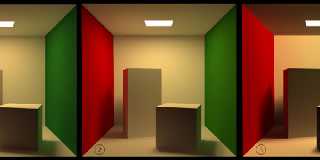My empirical studies with MegaPOV radiosity have shown that it
works as advertised. There are some other factors that are more
important for realism than the radiosity settings.
1. assumed_gamma & Display_Gamma
These parametrs relate only to the CRT and have nothing to do
with simulating light transport and should be taken out of
the simulation by using assumed_gamma 1.0. Display_Gamma should
be set to a value correct for the particular monitor.
2. Light source intensity distribution
In real life there are no omnidirectional light sources. By this I mean
that all ligh sources have some charachteristic intensity distribution.
In this scene the light source is a flat square panel. It's projected
area decreases by cos(angle) and so does it's brightness. For this reason
just using area_light isn't enough because it still radiates in all
directions with equal intensity (see fig.3). I used spotlight to simulate
this cosine falloff. (tightness 0 produces cos(angle*2)/2+0.5 intensity)
3. fade_power
In real life light source's apparent brightness follows 1/r^2 equation.
The correct value for fade_distance seems to be 1.4*light_source_diameter.
All three factors must be taken into account if relism is the goal.
As proof I present 3 images (gamma 2.2):
1) The Cornell reference image.
2) MegaPOV 0.5 image rendered with with:
assumed_gamma 1.0, Display_Gamma=2.2
spotlight modifier
fade_power 2
This is a nice match with basically the default MegaPOV radiosity settings.
All texture and radiosity parameters within nominal range.
3) The same scene with same settings without:
assumed_gamma
spotlight modifier
fade_power
(Texture and light colors gamma corrected)
This is a typical 1st attempt at radiosity. Too much color bleed,
not enough diffuse light, flat shading.
Once again, the difference between images 2 and 3 is caused by
assumed_gamma, spotlight and fade_power. Source to binaries.scene-files
by Monday.
_______________________________________________________________________
Kari Kivisalo www.kivisalo.net
Post a reply to this message
Attachments:
Download 'realistic.jpg' (26 KB)
Preview of image 'realistic.jpg'

|




![]()